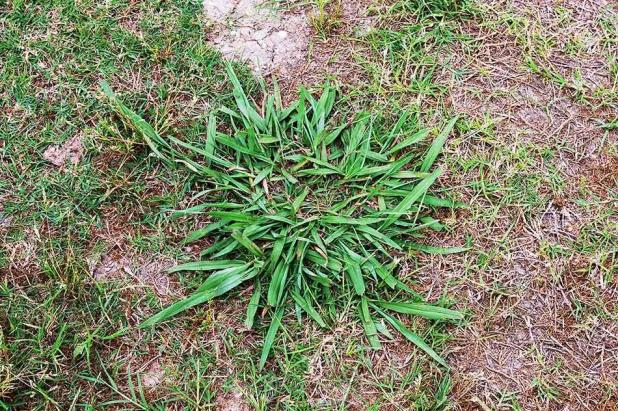
Dallisgrass is common in compacted soils
—LSU AgCenter/Ron Strahan
Get It Growing: Learn to read your weeds
Weeds can be a major pain for the home gardener. They compete for nutrients, water and light, and let’s face it, they’re just ugly. Summer days make growing easy for weeds. When some of our summer ornamental plants become stressed in the heat and extended periods of drought, weeds find it optimal, and they set up camp.
Weeds are really just any plant that is growing where we don’t want it to be. In school we were taught they are just a plant out of place.
Weeds are plants that establish naturally and pop up all over our landscape where they find the opportunity to do so. In our lawns, it is typically in areas where turfgrass is stressed or in beds where ample water, nutrients and light are usually found.
But did you know, weeds can actually tell you a lot about what is going in the yard and the quality of your soil? We call them indicator plants, and they are a wonderful tool for telling you about the health of your yard and landscape. Yes, your weeds can provide you with important information about your soil type, its fertility and pH, and if you have poor drainage or dry soil. That’s a whole lot of information if you are able to interpret it just by the types of weeds you find growing there.
Let’s learn how to read your weeds.
Several weeds will tell you your lawn has low fertility just by growing there. Some examples include dandelion, thistle, crabgrass, ragweed, yarrow, oxeye daisy, pearly everlasting, plantain, clover, sorrel, lespedeza, Queen Anne’s lace, white clover, sheep sorrel and mullein.
Dandelion indicates a soil that is low in calcium and high in potassium. (It is also edible, so grab a fork.) Crabgrass grows in low-calcium and overall low-nutrient soils. Wood sorrel (oxalis) indicates low-calcium and high-magnesium soils. Sheep sorrel indicates low calcium and nutrients. Yarrow also indicates low fertility and low potassium. White clover and lespedeza are both great indicators of low nitrogen fertility.
Use this information to properly fertilize your soils. In most cases, in the lawn, these weeds indicate a need for nitrogen. Remember, when turfgrass is healthy and growing vigorously, weeds find it harder to grow. Take care of weeds in late February and early March, and then fertilize your lawn in April and again in June. St. Augustine grass and bermudagrass can be fertilized up to three times in the summer starting in April after the threat of the last freeze, and every other month into the fall (April, June and August). Centipede lawns really only require one good fertilizer application in spring. Zoysia can take two to three fertilizer applications on the every-other-month cycle.
I rely on weeds to tell me where I have poor drainage in my yard. I typically find weeds will grow where my grass won’t. When we get a heavy rain and I can see the standing water in an area, it is often confirmed.
You will find the following weeds growing in poorly drained soils: dollarweed (another edible), dicondra (ponyfoot), bitter dock, goldenrod (dock), oxeye daisy, sensitive fern, spotted spurge, moss, purple and yellow nutsedge, goosegrass, doveweed, green kyllinga, chickweed, violet, bluegrass, bermudagrass, mouse-ear chickweed, morning glory, horsenettle, knotweed, bindweed, ground ivy and speedwell.
If you find any of these in a concentrated area, it is a good indicator of poor drainage. You can correct the drainage issue by raising the soil level in that area by filling in the low spots with top soil or garden soil.
In some instances, subsurface drainage may need to be installed. You can also re-grade or create some sloping to improve drainage. Heavy clay soils make drainage a difficult and expensive task. I know. I have been fighting this in my own yard. In some cases, I have simply decided to install a raised bed for ornamental plants, instead. Now I have a beautiful rose bed and a pollinator bed.
Speaking of heavy clay soils, some weeds that indicate this type of soil are redroot pigweed (aka amaranth), bindweed, chickweed (aka chicory), knotweed, plantain, goosegrass, dallisgrass and white clover. Heavy clay soils are easily compacted, so these weeds are also another indicator of compacted soil in areas of the lawn with heavy foot traffic. Aerification is a great way to combat compaction. Help loosen these severely compacted areas by poking holes or removing small plugs with aerifying tools.
In overly dry soils and sandy soils, you will often find mustard weed, carpetweed, Russian thistle, yarrow and speedwell. Amending the soil in those areas with organic matter to help with water retention. Additionally, supplemental hand watering or irrigation will help improve the health of plants growing there. Give them a leg up by removing the weeds.
Another issue can be shade, specifically in lawns that are predominantly turfgrass. Basketgrass is a perennial grass that’s common throughout shady areas of the lawn. St. Augustine is our go-to turfgrass for shade areas, but basketgrass is more tolerant and more competitive in shade than St. Augustine grass. However, there is no selective control to remove basketgrass in St. Augustine grass. If this is a problem for you, it is time to cut limbs up in the tree to provide more sunlight or just go ahead and mulch the area or install shade-tolerant plants instead of turf.
Many of these weeds will indicate more than one problem and serve as multi-diagnosis tools. Some are listed in more than one category. So while weeds may be a real pain in the neck for most home gardeners, those who know how to read them will know what is going on in their yards.
